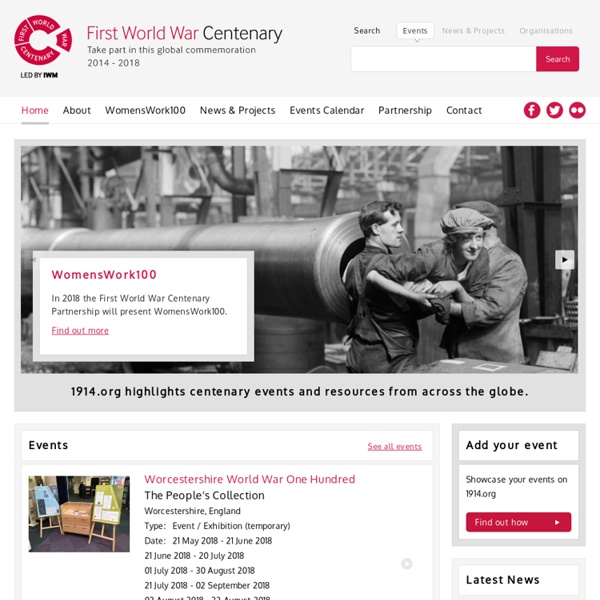



Youth for Peace À l’occasion de la commémoration de la fin de la Première Guerre mondiale, la rencontre internationale « Youth for Peace » réunit du 14 au 18 novembre 2018 à Berlin des jeunes issus de 48 pays. Retrouvez ici une description détaillée du projet, les renseignements essentiels sur la rencontre, le concept pédagogique sous-jacent, les partenaires du projet ainsi que toutes les informations importantes concernant la presse et la communication. La rubrique « 100 projets pour la paix » présente les 20 projets sélectionnés chaque année dans le cadre de l'appel à projets « 100 ans après la Première Guerre mondiale - 100 projets pour la paix en Europe ». La rubrique « autres projets » recense les nombreux projets subventionnés par l'OFAJ dans le cadre du Centenaire de la Première Guerre mondiale. Enfin, la rubrique intitulée « travail de mémoire et éducation à la paix » propose un accompagnement dans le domaine de la pédagogie.
Lives of the First World War - Home page 2014-2018: 100 Jahre Erster Weltkrieg - Contre l’oubli Le myosotis, ou "Vergissmeinnicht" en allemand ("ne m’oubliez pas"), est un symbole international du souvenir et des tendres adieux, et il est lié au souhait de continuer à exister dans la mémoire d’un être cher. Dans de nombreuses langues, il porte un nom qui a une signification similaire. Cette fleur a fait l’objet d’un grand nombre de poèmes et de chansons. Cette "fleur bleue" est un motif courant du Romantisme allemand ; elle représente la nostalgie et l’amour. Elle exprime entre autres l’aspiration vers un idéal, ainsi que la vanité de la recherche humaine du bonheur parfait. Beaucoup de jeunes gens qui se sont engagés volontairement au commencement de la Première Guerre mondiale,ignorant les cruelles conséquences de l’utilisation des armes modernes, étaient bercés par le Romantisme et ont idéalisé le dévouement personnel envers la patrie. En 1926, le symbolisme de la fleur de myosotis a été choisi par les francs-maçons comme signe de reconnaissance interne.
Operation War Diary Commémoration de la Première Guerre mondiale en Belgique Europeana Collections 1914-1918 - Untold Stories of the First World War Photos, letters and other memorabilia It was the war that tore Europe apart – a struggle between the central powers of Germany, Austria-Hungary, Turkey and Bulgaria, against the allied powers of Britain, France, Belgium, Russia, Italy and the USA. No European nation was left untouched – even neutral states felt the impact of the war. But it was the ordinary men and women who were affected the most. This exhibition gives those personal accounts from across Europe for the first time, based on stories and items contributed by the public. Renowned historian and WW1 author Peter Englund said: “This important and imaginative project tells the other side of the story, from the point of view of a young soldier who signed up seeking adventure, to the family devastated by news that he was one of millions who would never return.
The Great War Archive Happy Valentine's Day My Angel last night I received a letter from you. I learned how strong was the pain on the day we had to separate. Do you remember those beautiful kisses? This moving love letter was sent by Sergeant Major Giuseppe Castellani, to his wife Antonia at home in Fossato di Vico, while he was away serving in the Italian army during the First World War. Images: "Memory of our glorious Alps" sent 19 September 1917, and reverse View the full story and the images here. Words by Alun Edwards and Monica Rossi, University of Oxford